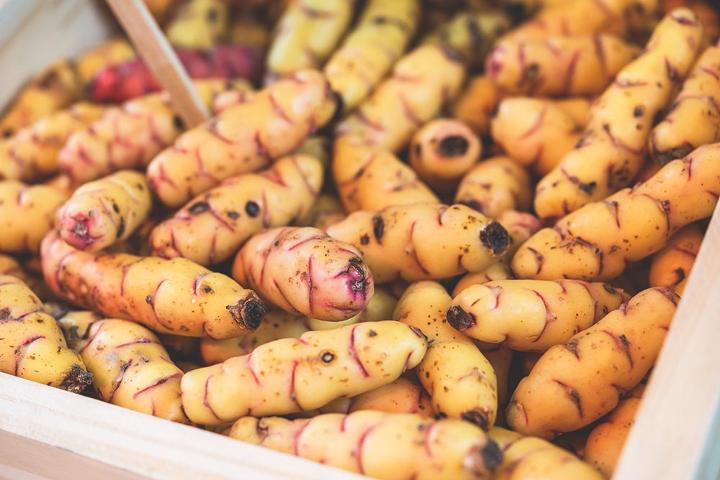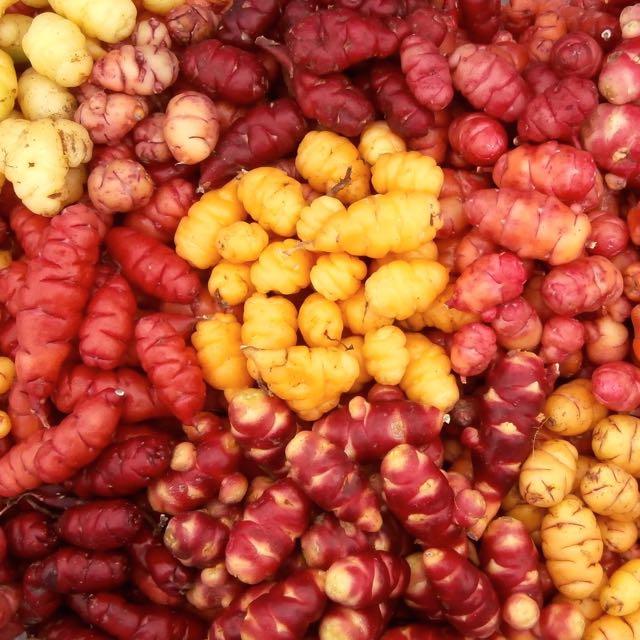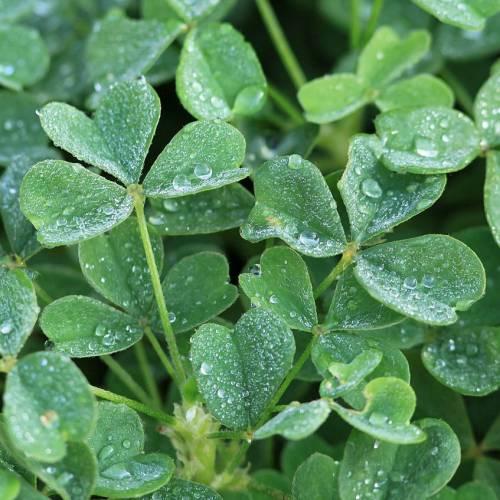Oca Plant
Oca, a perennial, requires well-drained, loamy soil and full sun. It's frost-sensitive and prefers moist conditions.
Habit
Perennial
Height
0.3-0.5 m
Growth
moderate
Soil
Well-drained, sandy loam
Shade
Full Sun
Moisture
Moist
Edible
Yes
Medicinal
No
Origin
South America
Climatic Condition
Subtropical, Temperate
Temperature (°)
15-25°C
Humidity (%)
50-60%
Potting media
Loamy, peat
Fertilizers
Organic, balanced NPK
Watering
Regular, moderate
Plant Weight
200-300 g
Flowering Time
Summer, Fall
Soil Ph level
5.5 - 6.5
Water Ph level
6.0 - 7.0
Soil EC
1-2 dS/m
Yield Per Plant
Edible tubers
NPK ratio
5:10:10
life Span
Perennial
Health Benefits
Rich in carbohydrates, antioxidant-rich
Common Diseases and Remedies
Bacterial stem rot.
Stem becomes hallow, Wilting.
Remove infected plants.
HEALTH BENEFITS
- Rich in vitamin C, supporting immune health.
- Contains antioxidants that protect against free radicals.
- Supports gut health due to its high fiber content.
- Helps regulate blood sugar levels.
What Is Oca Plant?
The Oca Plant, also known as New Zealand Yam or Oxalis tuberosa, is a tuberous root vegetable native to the Andes of South America. It is known for its edible tubers that come in a variety of colors, including red, purple, yellow, and white. Oca tubers have a tangy, lemony flavor and are rich in vitamin C. They can be cooked in a similar way to potatoes. B. boil, fry, or roast. Oka plants are grown in areas with cool climates and well-drained soils. Oca, scientifically known as Oxalis tuberosa, is a perennial herbaceous plant native to the Andes Mountains of South America. It is cultivated for its edible tubers that resemble small, elongated potatoes. Oca tubers come in a variety of colors, including red, pink, yellow, and orange, and have a spicy taste. Oca is grown as a food crop in parts of South America, but its nutritional value and adaptability to different climates have made it popular in other regions.

What Are The Different Types Of Oca Plant?
1. Standard Oka
This is a traditional oka variety with tubers that range in color from yellow to red to pink.
2. Red Oca
This type of Oca typically produces tubers with reddish skin and may have a slightly different flavor profile compared to standard Oca.
3. Yellow Oca
As the name suggests, this variety produces tubers with yellow skin. This is one of the most common types of OCA.
4. Pink Oka
The Pink Oka variety produces tubers with pink skin. It is highly praised for its unique appearance.
5. Bitter Oca
Some varieties of oca have a bitter taste, which is usually reduced by cooking. These varieties may have specific culinary uses.

How To Care For Oca Plant?
1. Location
The Oca Plant (Oxalis tuberosa) is native to the Andes Mountains of South America, particularly Peru and Bolivia. It grows in cool, high-altitude environments with well-drained soil and plenty of sunlight. Therefore, if you are thinking of growing Oca, try to replicate these conditions as closely as possible.
2. Sunshine
Oka Plants generally prefer full sun to partial shade. For optimal growth, ensure at least 6 hours of sunlight per day. However, it can also tolerate some shade, especially in hot climates. Pay attention to your plant's response to sunlight and adjust placement accordingly.
3. Soil
Oka plants prefer well-drained soil with a slightly acidic to neutral pH value (approximately 6.0-7.0). A mixture of sandy loam soil and compost or well-rotted manure works well. Oca plants do not tolerate waterlogging, so provide good drainage to avoid waterlogging.
4. Hydration
To properly hydrate your Oca Plant, make sure it is watered evenly. Oca plants prefer moist, well-drained soil. Water the plant when the top of the soil feels dry to keep the soil evenly moist but not soggy. Avoid letting the soil completely dry out between waterings, as this can stress the plant. Also, ensure proper drainage to prevent water blockages that can cause root rot.

5. Nourishment
Oka plants grow in well-drained soil that is rich in organic matter. Regular watering is beneficial, especially during dry periods. However, be careful not to give too much water as this can easily cause root rot. Additionally, feed with a balanced fertilizer, preferably one high in potassium, to promote tuber development. Avoid fertilizers that are high in nitrogen, as they can promote leaf growth at the expense of tubers.
6. Issues
The most common problem here is bacterial stem rot, which usually occurs late in the growing season and has little effect on yield. Oca cultivars often test positive for two different groups of viruses, but have no symptoms on the leaves or on the fruit.
What Are The Benefits Of Oca Plant?
The Oca Plant, also known as Oxalis tuberosa, has several benefits Nutritional Value Oca tubers are rich in carbohydrates, fiber, and vitamin C It is made using these ingredients as raw materials. A nutritious addition to your diet. Versatility Oca can be prepared in a variety of ways, including boiled, baked, fried, and added raw to salads, providing culinary versatility. Sustainability Oka is a hardy and resilient crop that can grow in diverse climates, contributing to food security and agricultural sustainability. Yield Stability Oka plants typically produce consistent yields even under difficult growing conditions, providing farmers with confidence. Crop flexibility Oka can be grown on marginal land or as an intercrop, allowing farmers to use space efficiently and diversify their farming practices. Cultural Significance Oca is culturally important in the Andean region, where it is traditionally grown and plays a role in local cuisine and customs. Genetic diversity Oca exhibits high genetic diversity, providing breeding programs with an opportunity to develop improved varieties with desirable traits such as disease resistance and high yield.

FAQs About Growing Oca Plant
1. How to maintain oca plant?
Sunlight Ensure your Oca plant receives plenty of sunlight, preferably 6-8 hours of sunlight per day. Watering Keep the soil consistently moist but not waterlogged. Water the plant regularly, especially during dry periods, and avoid letting the soil dry out completely. Soil Plant Oca in well-draining soil rich in organic matter. A slightly acidic to neutral pH (around 6.0-7.0) is ideal. Fertilizing Apply a balanced fertilizer once a month during the growing season to promote healthy growth. Avoid over-fertilizing, as it can lead to excessive foliage growth at the expense of tuber development. Mulching Mulch around the base of the plant to help retain moisture and suppress weeds. Pest and Disease Control Keep an eye out for pests such as aphids, slugs, and snails, and treat infestations promptly. Additionally, ensure good air circulation around the plants to prevent fungal diseases. Harvesting Harvest Oca tubers when they reach a desirable size, usually after the foliage has died back naturally. Be gentle when harvesting to avoid damaging the delicate tubers. Storage Cure harvested Oca tubers by leaving them in a cool, dry place for a few days to allow the skins to harden. Store them in a cool, dark, and well-ventilated area for long-term storage.
2. What are the uses of oca plant?
The oca plant, also known as Oxalis tuberosa, has several uses Edible tubers Oca produces tubers that are rich in carbohydrates and can be cooked and eaten like potatoes. They have a slightly tangy flavor and come in various colors. Ornamental plant Some varieties of oca are grown for their attractive foliage and flowers, making them suitable for ornamental purposes in gardens. Medicinal uses In traditional medicine, oca has been used to treat various ailments, although scientific evidence supporting its medicinal properties is limited. Crop rotation Oca can be used as a rotation crop to improve soil fertility and structure due to its nitrogen-fixing abilities. Genetic research Oca is studied for its genetic diversity and potential traits that could be useful for breeding programs to develop improved varieties with desirable characteristics.
3. Can I grow oca plant indoor?
Oca plants can be grown indoors, but they typically require a good amount of sunlight, so you'll need to ensure they receive adequate light, either through natural sunlight or artificial grow lights. Additionally, make sure to provide well-draining soil and regular watering. With proper care, you can successfully grow oca indoors.
4. Which pot is best for growing oca plant?
When growing oca plants, it's best to choose a pot that is at least 12 inches deep to accommodate their root system. Additionally, opt for a pot with good drainage to prevent waterlogging, which can cause root rot. A clay or ceramic pot can be suitable as they provide better airflow to the roots compared to plastic pots. Make sure the pot is placed in a location where the oca plant will receive ample sunlight.
5. From where can I shop for oca plant?
You can try searching for oca plants at local nurseries, garden centers, or online plant retailers specializing in unusual or exotic plants. Additionally, you might find them at farmers' markets or through gardening clubs or forums where enthusiasts trade or sell uncommon plant varieties.

